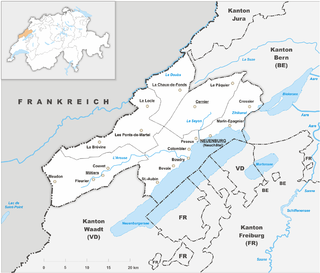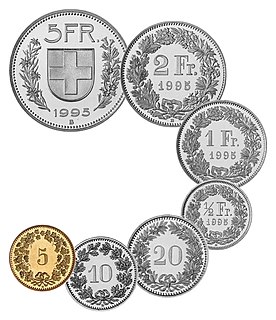
The real was a unit of currency in Spain for several centuries after the mid-14th century, but changed in value relative to other units introduced. In 1864, the real was replaced by a new escudo, then by the peseta in 1868, when a real came to mean a quarter of a peseta. The most common denomination for the currency was the Real de Ocho or Spanish dollar used throughout Europe, America and Asia during the height of the Spanish Empire.
The Gulden was the currency of the states of southern Germany between 1754 and 1873. These states included Bavaria, Baden, Württemberg, Frankfurt and Hohenzollern. This specific Gulden was based on the Gulden or florin used in the Holy Roman Empire during the Late Middle Ages and Early Modern period.

The Gulden was the currency of Bavaria until 1873. Between 1754 and 1837 it was a unit of account, worth 5⁄12 of a Conventionsthaler, used to denominate banknotes but not issued as a coin. The Gulden was worth 50 Conventionskreuzer or 60 Kreuzer Landmünze.
The Gulden was the currency of Württemberg until 1873. Until 1824, the Gulden was a unit of account and was used to denominate banknotes but was not issued as a coin. It was worth 5⁄12 of a Conventionsthaler and was subdivided into 50 Conventionskreuzer or 60 Kreuzer Landmünze.

The Frank was the currency of the Swiss canton of Aargau between 1798 and 1850. It was subdivided into 10 Batzen, each of 4 Kreuzer or 10 Rappen.

The Basel Thaler was the currency of the Swiss Canton of Basel until 1798. The currency was issued by both the Canton and the Bishopric of Basel.
The Gulden was the currency of the Swiss canton of Fribourg until 1798. It was subdivided into 14 Batzen, each of 4 Kreuzer or 16 Denier. It was replaced by the Frank of the Helvetian Republic in 1798. This was, in turn, replaced by the Fribourg Frank.
The Frank was the currency of the Swiss canton of Fribourg between 1798 and 1850. It was subdivided into 10 Batzen, each of 4 Kreuzer or 10 Rappen.
The Frank was the currency of the Swiss canton of Glarus between 1798 and 1850. It was subdivided into 100 Rappen, with the Schilling worth 3 Rappen.

The Frank was the currency of the Swiss canton of Luzern between 1798 and 1850. It was subdivided into 10 Batzen, each of 10 Rappen or 20 Angster.
The gulden was the currency of the Swiss canton of Luzern until 1798. It was subdivided into 40 schilling, each of 3 rappen or 6 angster. Coins were also issued denominated in kreuzer and batzen. It was replaced by the franc of the Helvetic Republic in 1798. This was, in turn, replaced by the Luzern frank.
The Thaler was the currency of St. Gallen until 1798. It was subdivided into 2 Gulden, each of 60 Kreuzer or 240 Pfennig. It was replaced by the Frank of the Helvetian Republic in 1798. This was, in turn, replaced by the St. Gallen Frank. Coins were issued by both the Abbey of St. Gall and the City.
The Frank was the currency of the Swiss canton of St. Gallen between 1798 and 1850. It was subdivided into 10 Batzen, each of 4 Kreuzer or 16 Pfennig.
The Gulden was the currency of the Swiss canton of Schwyz until 1798. It was subdivided into 40 Schilling, each of 3 Rappen or 6 Angster. Coins were also issued denominated in Groschen. It was replaced by the Frank of the Helvetian Republic in 1798. This was, in turn, replaced by the Schwyz Frank.
The Frank was the currency of the Swiss canton of Schwyz between 1798 and 1850. It was subdivided into 10 Batzen, each of 10 Rappen or 20 Angster.
The Frank was the currency of the Swiss canton of Solothurn between 1798 and 1850. It was subdivided into 10 Batzen, each of 4 Kreuzer or 10 Rappen.
The Frank was the currency of the Swiss canton of Thurgau between 1798 and 1803. It was subdivided into 10 Batzen, each of 4 Kreuzer.
The thaler was the currency of the Swiss canton of Valais until 1798. It was subdivided into 40 batz, each of 4 creuzer. It was replaced by the Frank of the Helvetian Republic in 1798.

The franc was the currency of the Swiss canton of Vaud between 1798 and 1850. It was subdivided into 10 batz, each of 10 rappes. The usual price unit was the Batz.

The Frank was the currency of the Swiss canton of Zürich between 1798 and 1850. It was subdivided into 10 Batzen, each of 10 Rappen, with 3 Heller to the Rappen and 4 Rappen to the Schilling.









